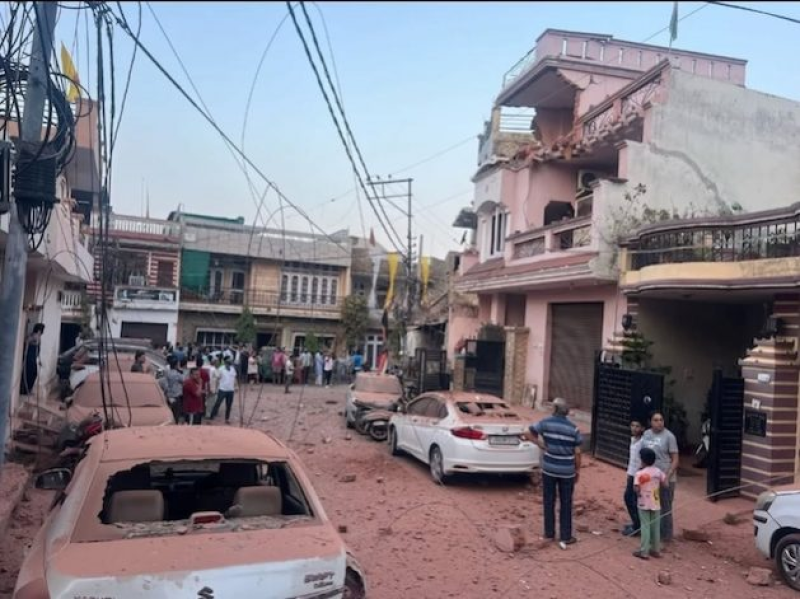- CA Yunus pays homage to Liberation War martyrs on Victory Day |
- Bangladesh capital market extends losing streak for second day |
- Bangladesh celebrates Victory Day Tuesday |
- 'Different govts presented history based on their own ideologies': JU VC |
Kashmir Ceasefire Brings Silence, Not Safety or Solace

Houses lie in ruins after Pakistani shelling in Jammu, India. (Handout)
In the war-worn borderlands of Jammu and Kashmir, the silence that followed the May 10 ceasefire between India and Pakistan is not the comforting kind. It is uneasy and fragile.
After a week of intense cross-border shelling that killed at least 16 civilians and displaced thousands, the truce—brokered by U.S. President Donald Trump—brought a halt to the violence. But for residents of villages along the Line of Control (LoC)—Uri, Kupwara, Rajouri, Poonch—the wounds are deeper than shattered homes.
The ceasefire's official call for an “immediate and full cessation of hostilities” quieted the guns, but not the grief. Funeral pyres still burn. Children refuse to sleep. Schools remain shut. Trauma hangs in the air like smoke.
Ruqaya Bano, 24, from Uri, was meant to be married this week. Instead, she stood over her mother’s grave, holding the embroidered dupatta of her bridal dress. Her mother, Haseena Begum, was killed when a mortar landed in their courtyard.
“She was helping me pack my wedding clothes,” Ruqaya said. “She smiled that morning and said, ‘Soon this house will be full of music.’ Hours later, we were digging her grave.”
Four others were killed in the same barrage—civilians all. Many more were wounded. With schools shuttered, children are left to process trauma alone.
Eight-year-old Mahir sits silent on a thin mattress at a Baramulla relief camp, eyes fixed on a blank wall. He hasn’t spoken since the shelling began.
“He watched his cousin Daniyal die near their cowshed,” said Abdul Rasheed, Mahir’s uncle and a farmer from Kupwara. “Now, if a dog barks or a door slams, he hides under the bed.”
His case is not isolated. Dozens of children show signs of acute stress—mutism, sleeplessness, bedwetting, panic attacks. In Kashmir, trauma walks through doors with the shrapnel.
The violence erupted after the April 22 terror attack in Pahalgam that killed 26 people, including 13 soldiers. India responded with air strikes on militant camps across the LoC. Pakistan returned fire, prompting mass evacuations from border villages.
In Rajouri and Samba, panic spread quickly. Families fled in the dead of night. Fuel stations saw mile-long queues. ATMs ran dry. Public buildings turned into shelters.
“There were mothers with babies and nothing to feed them,” said Aamir Dar, a volunteer from a Srinagar-based relief group. “The fear was absolute.”
Following two days of urgent diplomacy, President Trump announced the ceasefire via Truth Social: “Statesmanship has prevailed.”
Guns fell silent. Indian jets returned to base. But for those who lost homes and loved ones, it came too late.
In Salotri village, Poonch, 70-year-old Naseema Khatoon stands barefoot on scorched earth, before the remains of her two-room home. Her husband died in the 2019 skirmishes.
“Now the house is gone too,” she says. “How many times do we begin again?”
Amid devastation, villagers rally. Youth form human chains to pass sacks of rice. Volunteers set up makeshift clinics. University students from Srinagar launch online campaigns for food and medicine.
Hope survives—but faintly.
Even Jammu city, far from the LoC, wasn’t spared. On May 9, alarms warned of a possible missile strike near the airport. Panic surged. Mobile networks collapsed. Bunkers filled.
“It reminded me of the Kargil War,” said Rajesh Mehra, a retired teacher. “We slept in our clothes, bags packed.”
The missile threat proved false, but trust was shaken. Emergency supplies were airlifted. Trains were arranged for the stranded. When families returned, many found their homes in ruins.
In Tangdhar, a school now operates under a torn army tent. The smell of diesel and dread fills the air.
“I want to be a child again,” 13-year-old Laiba murmurs, clutching a pencil. “Not someone who remembers bombs.”
The shelling has left behind more than memories—fields littered with unexploded ordnance, homes cracked by shockwaves, hospitals stretched to breaking point.
The army has sealed danger zones. But for now, a casual misstep could still mean death.
Back in Uri, Ruqaya lays a garland on her mother’s grave, freshly dug beneath their walnut tree.
“She always believed peace would return,” Ruqaya whispers. “No guns, no fear. Maybe that day is still far off. But I hope it comes. For everyone.”
She wipes her tears and lifts a hammer to help rebuild what war destroyed.
Kashmir has been a flashpoint since 1947, triggering three wars and countless skirmishes between India and Pakistan. Since the insurgency of the late 1980s, over 100,000 lives have been lost.
In 2019, India revoked Kashmir’s special constitutional status and split it into two union territories. Since then, Delhi has claimed a return to normalcy. But locals speak of a quieter kind of conflict—militarised calm, suppressed voices, growing fear.
Last October, municipal elections were held for the first time in five years. It was a step forward—but only a small one.
For now, the ceasefire holds. But in the homes and hearts of border villagers, the war echoes on. The silence after the shelling is not just absence—it carries the weight of every scream, every loss.

